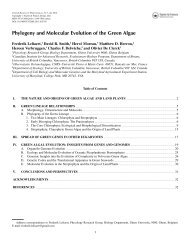The red algal genus Reticulocaulis from the Arabian
The red algal genus Reticulocaulis from the Arabian
The red algal genus Reticulocaulis from the Arabian
Create successful ePaper yourself
Turn your PDF publications into a flip-book with our unique Google optimized e-Paper software.
Phycologia (2003) Volume 42 (1), 44–55 Published 7 March 2003<br />
<strong>The</strong> <strong>red</strong> <strong>algal</strong> <strong>genus</strong> <strong>Reticulocaulis</strong> <strong>from</strong> <strong>the</strong> <strong>Arabian</strong> Sea, including<br />
R. obpyriformis sp. nov., with comments on <strong>the</strong> family Naccariaceae<br />
TOM SCHILS∗, OLIVIER DE CLERCK AND ERIC COPPEJANS<br />
Phycology Research Group, Biology Department, Ghent University, Krijgslaan 281 (S8), 9000 Ghent, Belgium<br />
T. SCHILS, O.DE CLERCK AND E. COPPEJANS. 2003. <strong>The</strong> <strong>red</strong> <strong>algal</strong> <strong>genus</strong> <strong>Reticulocaulis</strong> <strong>from</strong> <strong>the</strong> <strong>Arabian</strong> Sea, including R.<br />
obpyriformis sp. nov., with comments on <strong>the</strong> family Naccariaceae. Phycologia 42: 44–55.<br />
<strong>Reticulocaulis</strong> obpyriformis Schils, sp. nov. is described <strong>from</strong> <strong>the</strong> south coast of Socotra Island (Yemen), and a second<br />
species, R. mucosissimus, is recorded <strong>from</strong> a similar upwelling area in <strong>the</strong> <strong>Arabian</strong> Sea (Masirah Island, Oman). <strong>The</strong>se are<br />
<strong>the</strong> first published records of Naccariaceae for <strong>the</strong> Indian Ocean and end <strong>the</strong> monospecific, Hawaiian-endemic status of<br />
<strong>Reticulocaulis</strong>. Features distinguishing R. obpyriformis <strong>from</strong> R. mucosissimus include its more sparsely branched thallus,<br />
obpyriform ra<strong>the</strong>r than cylindrical inner cortical cells, <strong>the</strong> presence of short moniliform laterals of small spherical cells on<br />
<strong>the</strong> cortical filaments, monoecious ra<strong>the</strong>r than dioecious gametophytes, and <strong>the</strong> direct development of spermatangia <strong>from</strong><br />
catenate mo<strong>the</strong>r cells. <strong>The</strong> morphology and anatomy of <strong>the</strong> gametophytes of this heteromorphic <strong>genus</strong> are discussed in<br />
relation to those of o<strong>the</strong>r naccariacean genera.<br />
INTRODUCTION<br />
Recent phycological studies in <strong>the</strong> <strong>Arabian</strong> Sea and <strong>the</strong> nor<strong>the</strong>rn<br />
Indian Ocean have resulted in <strong>the</strong> description of new taxa<br />
(Wynne 1999a) and a plethora of new records (Wynne & Banaimoon<br />
1990; Wynne & Jupp 1998; Wynne 1999b, 2000) indicative<br />
of a unique marine benthic flora. <strong>The</strong> south-west<br />
monsoon that results in upwelling along <strong>the</strong> south-eastern<br />
coastline of <strong>the</strong> <strong>Arabian</strong> Peninsula (Currie et al. 1973; Ormond<br />
& Banaimoon 1994) is an important physical phenomenon<br />
influencing <strong>the</strong>se neritic ecosystems and <strong>the</strong>ir biotas, particularly<br />
those of Masirah Island (Oman) and <strong>the</strong> Socotra Archipelago<br />
(Yemen), which support a seasonally rich diversity<br />
of gelatinous <strong>red</strong> algae (Schils & Coppejans 2002). Among<br />
<strong>the</strong> more unexpected of <strong>the</strong> algae recently discove<strong>red</strong>, <strong>the</strong>re<br />
are two species of <strong>Reticulocaulis</strong>, a hi<strong>the</strong>rto monotypic <strong>genus</strong><br />
thought to be confined to Hawaii in <strong>the</strong> central Pacific Ocean<br />
and a member of <strong>the</strong> relatively little-known and infrequently<br />
encounte<strong>red</strong> family Naccariaceae.<br />
Following <strong>the</strong> recommendations of Kylin (1928), Svedelius<br />
(1933) and Feldmann & Feldmann (1942), <strong>the</strong> Naccariaceae<br />
is generally included in <strong>the</strong> order Bonnemaisoniales, based on<br />
details of gonimoblast development and <strong>the</strong> presence of nutritive-cell<br />
clusters on <strong>the</strong> carpogonial branch (Chihara &<br />
Yoshizaki 1972), an ordinal placement supported by ultrastructural<br />
characters of <strong>the</strong> pit plugs (Pueschel & Cole 1982).<br />
Womersley (1996), however, commented that <strong>the</strong> family might<br />
not be related to <strong>the</strong> Bonnemaisoniaceae, because of some<br />
seemingly major differences in <strong>the</strong> carposporophyte, such as<br />
a diffuse ra<strong>the</strong>r than compact gonimoblast and <strong>the</strong> complete<br />
absence of a pericarp. Abbott (1999) recently placed <strong>the</strong> Naccariaceae<br />
in <strong>the</strong> Gigartinales without specifying her reasons<br />
for <strong>the</strong> transfer. <strong>The</strong> Naccariaceae currently comprises <strong>the</strong><br />
genera Atractophora P. Crouan & H. Crouan, Naccaria Endlicher<br />
and <strong>Reticulocaulis</strong> I.A. Abbott. Despite consisting of<br />
only seven species, of which five belong to Naccaria, <strong>the</strong><br />
∗ Corresponding author (tom.schils@rug.ac.be).<br />
family is widely distributed throughout <strong>the</strong> Atlantic and Pacific<br />
Oceans. Although a single robust female gametophyte of<br />
N. naccarioides (J. Agardh) Womersley & I.A. Abbott is<br />
known <strong>from</strong> <strong>the</strong> Indian Ocean coast of Western Australia<br />
(GEN-10793e, MELU: leg. G.T. Kraft & G.W. Saunders, 7<br />
October 1995, Pinaroo, Western Australia, 32.20S, 115.45E),<br />
<strong>the</strong> present article is <strong>the</strong> first published report on a member<br />
of <strong>the</strong> Naccariaceae <strong>from</strong> anywhere in <strong>the</strong> Indian Ocean.<br />
MATERIAL AND METHODS<br />
<strong>The</strong> east coast of Masirah Island (Oman; 20.42N, 58.79E;<br />
Figs 1, 2) and <strong>the</strong> south coast of Socotra (Yemen; 12.47N,<br />
53.87E; Figs 1, 3) are influenced by a seasonal coastal upwelling<br />
<strong>from</strong> May to September, during <strong>the</strong> south-west monsoon.<br />
<strong>The</strong> specimens of this report were found in similar habitats<br />
around Masirah and Socotra, viz. rocky platforms at 10–<br />
20 m depth on which macroalgae were <strong>the</strong> most abundant<br />
benthic organisms, interspersed with isolated small hard and<br />
soft coral colonies. Gelatinous <strong>red</strong> algae such as Dudresnaya<br />
P. Crouan & H. Crouan, Gibsmithia Doty, Platoma Schousboe<br />
ex Schmitz and P<strong>red</strong>aea De Toni species (Schils & Coppejans<br />
2002), were particularly conspicuous during <strong>the</strong> early-winter<br />
and late-spring periods, o<strong>the</strong>r associated algae being Amphiroa<br />
J.V. Lamouroux spp., Callophycus Trevisan sp., Caulerpa<br />
peltata J.V. Lamouroux, Euptilota fergusonii Cotton, Galaxaura<br />
marginata (Ellis & Solander) J.V. Lamouroux, Halimeda<br />
J.V. Lamouroux spp., Lobophora variegata (J.V. Lamouroux)<br />
Womersley ex Oliveira, Rhodymenia Greville spp., Spatoglossum<br />
asperum J. Agardh, and Udotea indica A. Gepp & E.<br />
Gepp.<br />
Specimens of <strong>Reticulocaulis</strong> were collected by <strong>the</strong> first author<br />
during field trips to Masirah Island on 2–30 November<br />
1999 and Socotra on 26 March–7 May 2000, <strong>the</strong> subtidal habitats<br />
being accessed by means of SCUBA. <strong>The</strong> collected algae<br />
were pressed on herbarium sheets, with portions preserved in<br />
a 5% formalin–seawater solution. Herbarium sheets, wet spec-<br />
44

















